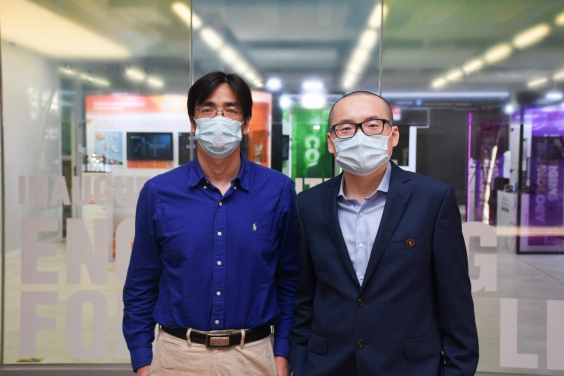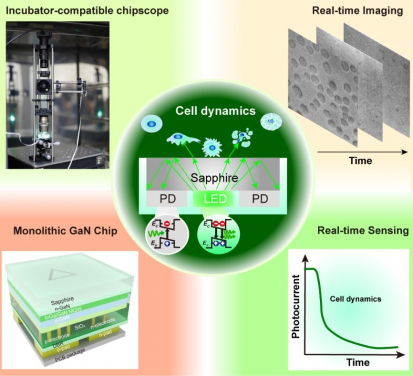Media
HKU Engineering team develops a novel photonic chipscope for label-free monitoring of live cell activities
16 Jun 2022
Label-free, non-invasive, and quantitative monitoring of cellular activities is crucial for understanding various biological processes and the response of cells to therapeutic drugs.
However, existing approaches are often hindered by their multiple time-consuming preparation steps, complicated apparatus, and incompatibility which may interfere with the cells and cause unwanted influence on them.
An interdisciplinary research team led by Dr Zhiqin Chu of the Department of Electrical and Electronic Engineering of the University of Hong Kong (HKU) and Dr Yuan Lin of the Department of Mechanical Engineering, HKU, in collaboration with Dr Kwai Hei Li from Southern University of Science and Technology, has developed a low-cost, highly miniaturized and incubator compatible GaN chipscope, which enables real-time monitoring of cells in the limited and humid space of an incubator.
This practical device would provide new insights into the fundamental research of cell biology and drug discovery and assist in the development of a new generation of biosensors. The team has filed for a US provisional patent.
Compared with conventional fluorescence molecules and radionuclide-based labeling techniques, label-free analysis enables biosignals changes to be monitored in real-time without artificial manipulation of individual samples. It allows the targeted samples to retain their intrinsic states, minimising the side effects on the native conformation and biological activity of the targeted ligands, cells, or tissues.
To date, the leading label-free sensing technology in the market is electric impedance sensing-based microelectronic sensors. This electric sensor contains an array of gold biosensors integrated into the well plate, allowing real-time impedance detection to track and quantify the living cell adhesion-related dynamics. However, the electric field employed there could potentially interfere with samples sensitive to electrical signals, such as nerves, and myocardium.
As alternatives, optical evanescence field based sensing approaches, including resonant waveguide grating biosensor (RWG) and surface plasmon resonance (SPR), have attracted intensive interest in recent years due to their non-invasive and label-free nature. Although these technologies have superior optical precision and have been widely used in the study of biomolecule interactions and living cell activities detection, they have a high demand for the testing condition and overall set-up, posing great constraints to their wide applications in diverse environments.
The established GaN-based monolithic chipscope integrates a customised mini differential interference contrast (DIC) microscope that can quantitatively monitor the progression of different intracellular processes in a label-free manner. It enables not only a photoelectric readout of cellular/subcellular refractive index (RI) changes but also the real-time imaging of cellular/subcellular ultrastructural features in the incubator.
The heart of this system is a miniaturised GaN photonic chip that integrates microscale InGaN/GaN based-light emission and photodetection subunits (LED-PD). Its unique stacked design of distributed Bragg reflector can dramatically enhance the light collection efficiency.
The miniaturised GaN photonic chip is capable of photoelectric detection, enabling the real-time refractive index monitoring induced by the collective cell behaviors at the chip surface. Meanwhile, benefitting from the integrated mini-DIC imaging system, users can clearly capture the cell morphology changes in real-time. By coupling the imaging unit and RI sensing unit, the platform can quantitatively recognise the cell behaviors in situ, including cell precipitation, initial attachment, spreading, shrinkage, etc. This practical, ready-to-use cell analyser has been successfully applied in pharmaceutical activity screening, and immune cell phenotypes transform track.
This research expands the applications of GaN photonic chips in the biosensing area. In particular, the combined strategy of chip sensor and optical imaging transcends the boundaries of the conventional “photonic chip” and “microscopy” monitoring processes. The resulting “chipscope” represents a significant and exciting advance in the development of biosensors.
The research work was published in an article entitled “A versatile, incubator-compatible, monolithic GaN photonic chipscope for label-free monitoring of live cell activities” in the top multidisciplinary journal, Advanced Science.
Link for the paper: https://onlinelibrary.wiley.com/doi/10.1002/advs.202200910
Media Enquiries
Ms Celia Lee, Faculty of Engineering, HKU (Tel: 3917 8519; Email: [email protected]) or Ms Charis Lai, Faculty of Engineering, HKU (Tel: 3917 1924; Email: [email protected])


